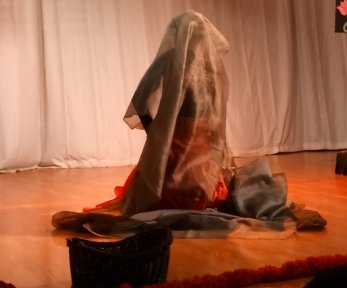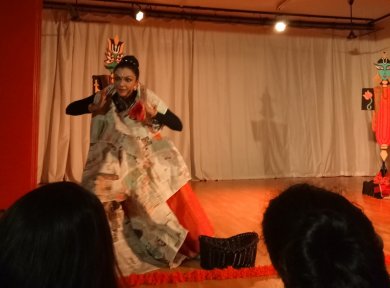
|   |

|   |
'A Million Sitas' by Dr. Anita Ratnam Kampni Kutcheri Chamber Concert Series - K Shridhar Hegde January 15, 2017 Natya Institute of Kathak and Choreography has always been known for bringing out pioneering projects in the field of dance. Recently, NIKC has launched a series of performances under the successful leadership of its current director Madhu Nataraj Kiran. Named as Kampni Kutcheri- Chamber Concert Series, it takes place once every month at the institute's dance space. Eminent musicians, dancers and theatre artists come here to perform in Kampni Kutcheri. The Kutcheri is special in many ways particularly in its traditional chamber concert like setup extended to dance and theatre. This setup establishes a unique connection between performers and spectators very similar in a way that used to happen in temple dances of the ancient times. One such occasion at 11th Kampni Kutcheri, 'A Million Sitas', a contemporary dance theatre by Dr. Anita Ratnam based on the epic story of Ramayana was to be performed that evening. The Kutcheri began with an introductory video on what NIKC is. Keerthi Kumar, project head of Natya STEM Dance Kampni, gave introduction on Kampni Kutcheri Series. Madhu Nataraj Kiran introduced the artist for the evening.  As Ahalya  As Manthara There were two figures on either side of the performance space. One among them was depicting Lord Rama and the other Ravana. As narrator, Anita Ratnam started with stories describing the birth of Sita. The presentation was woven around the stories of five well-known women characters of the story, namely Mandodari, Ahalya, Manthara, Surpanakha and of course Sita. Ahalya's character was portrayed using a long greyish silver cloth, pointing to her transformation into stone. Manthara, the root cause of Rama's exile, was depicted using the crushed dailies wrapped around the performer's body. Dr. Ratnam mentioned towards the end of the presentation that this particular concept was an impromptu improvisation. The narration continued to land on the act of insulting Surpanakha in a unique depiction. The performer wore a black wavy dress, long nails and a Balinese headgear. The movements were slow, steady and strong with a flavour of Kathakali and Mohiniyattam. The character ends with a shrill cry after her nose and ears get cut.  Sita's story was narrated through, but she comes out as a distinct character towards the end. Sita asks Rama for her justice. The well-known "Sita kalyana vaibhogame" song was sung near Rama's ears with a tinge of sarcasm. Then Dr. Ratnam comes out in a zulu wedding costume holding a lamp in her hand. The performance ends with Sita's sorrow and the injustice she has suffered being generalized to that of the women of today's world. The performance was a solo act using recorded music. It was in a single stage setting without any entry or exit of the narrator from the stage in between the presentation. A lot of symbolism went into the performance which uncovered various facets of each character. The dance theatre was choreographed with much movement but with slow and effective build up of the characters. Music was in coherence with movements and was mainly derived from south Asian folklore fused with western drums and chords every now and then. In totality, it was more like a garland of stories of five prominent women characters, the thread being the story of Ramayana itself. In the interaction session after the performance, Dr. Ratnam mentioned that the program also has an extended version, which includes the way in which five decisions of Sita carries the Ramayana story forward. Being a researcher herself in feminist studies, Anita Ratnam beautifully brings out the subtle emotions and questions that a woman experiences in the world. K. Shridhar Hegde is doing First Diploma (choreography), NIKC, Bangalore. |